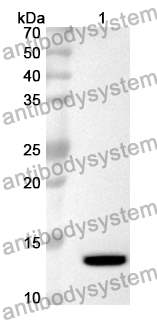Catalog No.
PHF85801
Species reactivity
Human
Host species
Rabbit
Isotype
IgG
Clonality
Polyclonal
Immunogen
E. coli - derived recombinant Human SRSF2/SC-35 (Met1-Ser101).
Tested applications
ELISA: 1:4000-1:8000, IHC: 1:50-1:100, WB: 1:1000-1:4000
Target
Splicing factor SC35, Splicing factor, arginine/serine-rich 2, SC-35, Serine/arginine-rich splicing factor 2, SFRS2, SRSF2, Splicing component, 35 kDa, Protein PR264
Purification
Purified by antigen affinity column.
Accession
Q01130
Applications
ELISA, IHC, WB
Form
Liquid
Storage buffer
0.01M PBS, pH 7.4, 50% Glycerol, 0.05% Proclin 300.
Stability and Storage
Use a manual defrost freezer and avoid repeated freeze thaw cycles. Store at 2 to 8°C for frequent use. Store at -20 to -80°C for twelve months from the date of receipt.
Long-term longitudinal analysis of 4,187 participants reveals insights into determinants of clonal hematopoiesis., PMID:39251642
Predicting recurrent glioblastoma clinical outcome to immune checkpoint inhibition and low-dose bevacizumab with tumor in situ fluid circulating tumor DNA analysis., PMID:39105794
Antibody-Based and Cell Therapies for Advanced Mastocytosis: Established and Novel Concepts., PMID:37894806
Using Proteome Microarray and Gene Expression Omnibus Database to Screen Tumour-Associated Antigens to Construct the Optimal Diagnostic Model of Oesophageal Squamous Cell Carcinoma., PMID:37433700
Low-Risk Myelodysplastic Syndrome Revisited: Morphological, Autoimmune, and Molecular Features as Predictors of Outcome in a Single Center Experience., PMID:35392224
Classification and Personalized Prognostic Assessment on the Basis of Clinical and Genomic Features in Myelodysplastic Syndromes., PMID:33539200
Identification of novel autoantibodies based on the protein chip encoded by cancer-driving genes in detection of esophageal squamous cell carcinoma., PMID:33457096
SON and SRRM2 are essential for nuclear speckle formation., PMID:33095160
Selection of Vaccinia Virus-Neutralizing Antibody from a Phage-Display Human-Antibody Library., PMID:30856707
RUNX1 Mutations Can Lead to Aberrant Expression of CD79a and PAX5 in Acute Myelogenous Leukemias: A Potential Diagnostic Pitfall., PMID:30396184
Transcriptome Analysis of Monozygotic Twin Brothers with Childhood Primary Myelofibrosis., PMID:28185911
Exercise capacity in chronic heart failure patients is related to active gene transcription in skeletal muscle and not apoptosis., PMID:19318954
Cajal bodies and interchromatin granule clusters in cricket oocytes: composition, dynamics and interactions., PMID:17123844
Basonuclins 1 and 2, whose genes share a common origin, are proteins with widely different properties and functions., PMID:16891417
Mimicking phosphorylation of the small heat-shock protein alphaB-crystallin recruits the F-box protein FBX4 to nuclear SC35 speckles., PMID:15511225
Clustering of multiple specific genes and gene-rich R-bands around SC-35 domains: evidence for local euchromatic neighborhoods., PMID:12975345
Nuclear staining for the small heat shock protein alphaB-crystallin colocalizes with splicing factor SC35., PMID:12924631
Nuclear distribution of Oct-4 transcription factor in transcriptionally active and inactive mouse oocytes and its relation to RNA polymerase II and splicing factors., PMID:12858338
Nucleocytoplasmic transport of proteins and poly(A)+ RNA in reconstituted Tpr-less nuclei in living mammalian cells., PMID:11952838
Further considerations on the intranuclear distribution of HMGI/Y proteins., PMID:11767201
Distinct changes in intranuclear lamin A/C organization during myoblast differentiation., PMID:11739632
Novel N-terminal variant of human VDR., PMID:11518809
PRCC, the commonest TFE3 fusion partner in papillary renal carcinoma is associated with pre-mRNA splicing factors., PMID:11313942
Nuclear distribution of RNA polymerase II in human oocytes from antral follicles: dynamics relative to the transcriptional state and association with splicing factors., PMID:10771521
A human importin-beta family protein, transportin-SR2, interacts with the phosphorylated RS domain of SR proteins., PMID:10713112
Intron-independent association of splicing factors with active genes., PMID:10366587
Substrate specificities of SR proteins in constitutive splicing are determined by their RNA recognition motifs and composite pre-mRNA exonic elements., PMID:10022872
Combined fluorescent and gold immunoprobes: reagents and methods for correlative light and electron microscopy., PMID:9712158
A comparative nuclear localization study of galectin-1 with other splicing components., PMID:9683529
The expression of the essential nuclear splicing factor SC35 is altered by human immunodeficiency virus infection., PMID:9617768
Subcellular localization of human immunodeficiency virus type 1 RNAs, Rev, and the splicing factor SC-35., PMID:9601515
Association of phosphorylated serine/arginine (SR) splicing factors with the U1-small ribonucleoprotein (snRNP) autoantigen complex accompanies apoptotic cell death., PMID:9463405
Sip1, a novel RS domain-containing protein essential for pre-mRNA splicing., PMID:9447963
Novel SR-protein-specific kinase, SRPK2, disassembles nuclear speckles., PMID:9446799
A covalent fluorescent-gold immunoprobe: simultaneous detection of a pre-mRNA splicing factor by light and electron microscopy., PMID:9212820
Structural protein 4.1 in the nucleus of human cells: dynamic rearrangements during cell division., PMID:9128242
Quantitative digital analysis of diffuse and concentrated nuclear distributions of nascent transcripts, SC35 and poly(A)., PMID:9056409
Transcription-dependent redistribution of nuclear protein 4.1 to SC35-enriched nuclear domains., PMID:9044054
Factors involved in the activation of pre-mRNA splicing from downstream splicing enhancers., PMID:8864844
Fine structural cytochemical and immunocytochemical analysis of nucleic acids and ribonucleoprotein distribution in nuclei of pig oocytes and early preimplantation embryos., PMID:8662249
An amino acid sequence motif sufficient for subnuclear localization of an arginine/serine-rich splicing factor., PMID:8524796
Localization of the glucocorticoid receptor in discrete clusters in the cell nucleus., PMID:8537440
Colocalization of a high molecular mass phosphoprotein of the nuclear matrix (p255) with spliceosomes., PMID:7657711
Influenza virus NS1 protein alters the subnuclear localization of cellular splicing components., PMID:9049349
Splicing components are excluded from the transcriptionally inactive XY body in male meiotic nuclei., PMID:7696714
Disruption of pre-mRNA splicing in vivo results in reorganization of splicing factors., PMID:8294510
Nuclear organization of splicing snRNPs during differentiation of murine erythroleukemia cells in vitro., PMID:8245117
Fluorescent labeling of nascent RNA reveals transcription by RNA polymerase II in domains scattered throughout the nucleus., PMID:8320255

